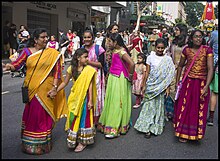 Ratha Yatra procession in Brisbane | |
| Total population | |
|---|---|
| 783,958 by ancestry (2021 census)[1] (3.1% of the Australian population)[1] 721,050 born in India (2020)[2] | |
| Regions with significant populations | |
| Melbourne, Sydney, Perth, Brisbane, Adelaide, Woolgoolga and Regional Victoria | |
| Languages | |
| Religion | |
| |
| Related ethnic groups | |
Indian Australians or Indo-Australians are Australians of Indian ancestry. This includes both those who are Australian by birth, and those born in India or elsewhere in the Indian diaspora. Indian Australians are one of the largest groups within the Indian diaspora, with 783,958 persons declaring Indian ancestry at the 2021 census, representing 3.1% of the Australian population.[1] In 2019, the Australian Bureau of Statistics estimated that 721,050 Australian residents were born in India.[3][4]
Indians are the youngest average age (34 years) and the fastest growing community both in terms of absolute numbers and percentages in Australia.[5]
In 2017–18 India was the largest source of new permanent annual migrants to Australia since 2016, and overall third largest source nation of cumulative total migrant population behind England and China, 20.5% or 33,310 out of 162,417 Australian permanent resident visas went to the Indians who also additionally had 70,000 students were studying in Australian universities and colleges, and Hindi (ranked 8th with 0.7% of total population) and Punjabi (ranked 10th with 0.6% of total population) are among the top 10 languages spoken in Australia.[6][7][8] Among Indian origin religions, which also include non-Indians, are Buddhist (2.4% of total population or 563,700 people), Hindus (1.9% or 440,300) and Sikhs (0.5% or 125,900).[7]
As of 2016, Indians were the highest educated migrant group in Australia with 54.6% of Indians in Australia having a bachelor's or higher degree, more than three times Australia's national average.[9]
The long history of Indian migration to Australia has progressed "from 18th-century sepoys and lascars (soldiers and sailors) aboard visiting European ships, through 19th-century migrant labourers and the 20th century's hostile policies to the new generation of skilled professional migrants of the 21st century... India became the largest source of skilled migrants in the 21st century."[10]
- ^ a b c "General Community Profile" (XLS). 2021 Census of Population and Housing. Australian Bureau of Statistics. Retrieved 20 December 2023.
- ^ "Table 5.1 Estimated resident population, by country of birth(a), Australia, as at 30 June, 1996 to 2020(b)(c)". Australian Bureau of Statistics. Retrieved 24 April 2021.
- ^ "2016 Census Community Profiles: Australia". quickstats.censusdata.abs.gov.au. Archived from the original on 20 April 2020. Retrieved 5 May 2019.
- ^ "Table 5.1 Estimated resident population, by country of birth(a), Australia, as at 30 June, 1996 to 2020(b)(c)". Australian Bureau of Statistics. Retrieved 24 April 2021.
- ^ Statistics, c=AU; o=Commonwealth of Australia; ou=Australian Bureau of (28 April 2020). "Main Features - Australia's Population by Country of Birth". www.abs.gov.au.
{{cite web}}: CS1 maint: multiple names: authors list (link) - ^ Indian population in Australia increases 30 per cent in less than two years; now the third largest migrant group in Australia, SBS, 2 May 2019.
- ^ a b Hindi is the top Indian language spoken in Australia, SBS, 26 October 2018.
- ^ Migration program report for 2017–18
- ^ Cite error: The named reference
educated2016was invoked but never defined (see the help page). - ^ The story of the Indian diaspora in Australia and New Zealand is 250 years old, qz.com, 30 October 2018.